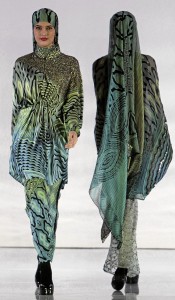Islamic fashion is no oxymoron. As the recent Islamic Fashion Festival (IFF) staged in Manila showed, there’s more to Muslim dressing than the traditional abaya, chador and even burka.
The collections of seven designers, including the Philippines’ JC Buendia, Jun Escario and Veejay Floresca, were noteworthy for their wearability, craftsmanship, variety and sophistication.
Organized by Malaysian Raja Rezza Shah, IFF was established in 2006 to create, in Shah’s words, an understanding between Muslim and non-Muslim countries that Islam isn’t about terrorism. To break this stereotype, Shah, with support from the Malaysian government, has staged the festival yearly beyond such Islamic cities as Kuala Lumpur, Jakarta and Dubai, to include New York, London and, more recently, Manila.
“IFF is not even about promoting a religion, but creating an understanding and breaking certain stereotypes about Islam,” Shah said. “And we can do this not through bombs and bullets, but through fashion shows. If you want to change certain perceptions, do it the gentle, beautiful and shiny way.”
To make the show more exciting for the host city, Shah includes the works of local talents, with those of Malaysian designers. The recent gala presentation at Hotel InterCon Manila’s grand ballroom included the works of Malaysian designers Tom Abang Saufi, Syaiful Baharim, Melinda Looi and Bali-based Italian Milo Migliavacca.
The by-invitation-only dinner was hosted by RJ Ledesma, Marc Nelson and Malaysian Bernie Chan, with Malaysian-British actor-singer Stephen Rahman-Hughes performing.
“Filipinos have always been very talented, very special,” Shah said. “Mixing Muslim with non-Muslim designers is the whole idea. We want to show the world that Islam isn’t limited to Arabs. It belongs to everyone regardless of race and culture.”
Neutral and tailored
Buendia was inspired by his favorite style icons Jackie Kennedy and Princess Diana to produce a collection of neutral and tailored separates, beaded jackets, tunics, cigarette pants, circle skirts and peplums. If you remove the black headscarves, sweaters and leotards, the collection is as Western and contemporary as Buendia’s trademark pieces. Despite some uncharacteristic juxtapositions, including flowing skirts with slim pants, his was easily one of the evening’s most cohesive and sophisticated collections.

He may have chosen black as anchor for his collection, but Floresca, the youngest among the Filipinos, made it more fun and colorful by mixing it with painterly and modernized batik prints inspired, he said, by artworks at the Victoria and Albert Museum in London.
Escario evoked red-carpet glamour in beaded, draped and clingy long dresses with contrasting matte and shiny elements. Obvious requirements such as long sleeves hardly limited the designer—he worked around such limitations by making the clothes more fitted, for instance.
Like Buendia, Escario used dark clingy sweaters and leggings for added cover-up. None of the designers, including the Malaysians, covered the faces of female models. Several designers presented men’s pieces.
Islamic fashion is fashion that adheres to Islamic values, said Ng Yen Yen, Malaysian minister of tourism. Although cover-up is a given in Muslim women’s fashion, Ng said that there are various ways to cover up.
“What we’re trying to tell the world through these shows is that it can also be beautiful, colorful, brilliant, graceful and wearable just like any other fashion.”
Malaysia aims to project to the world a more moderate brand of Islam, which advances “peace and progress,” she added.
Accomplished Filipino women
The show was restaged the next day over lunch in the same venue. To help with the groundwork, Shah taps the support of locals. Here he collaborated with such accomplished Filipino women as Tingting Cojuangco, Doris Magsaysay-Ho, Tina Ocampo and Fortune Ledesma.
“The purpose of this show is to create an understanding between cultures,” said Ho. “It gave them a different perspective about Muslims.”
Events like this, Ho added, are important for countries like the Philippines with considerable Muslim presence. The show also honors the country’s Muslim population.
Ocampo was amazed at the collections’ range, variety and wearability.
“If you take out the stockings, long sleeves and sweaters, you’re left with very credible pieces you can wear almost anywhere,” said Ocampo. “Each designer presented his or her unique point of view, which made the show more special. I’m proud of what our Filipino designers did.”
Over breakfast with the Malaysian ambassador to Manila early this year, Ocampo and company were asked if they could help Shah mount the show here. The women readily agreed.